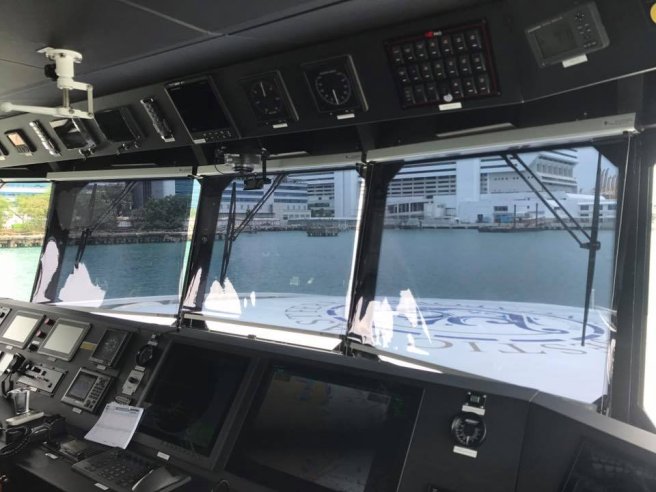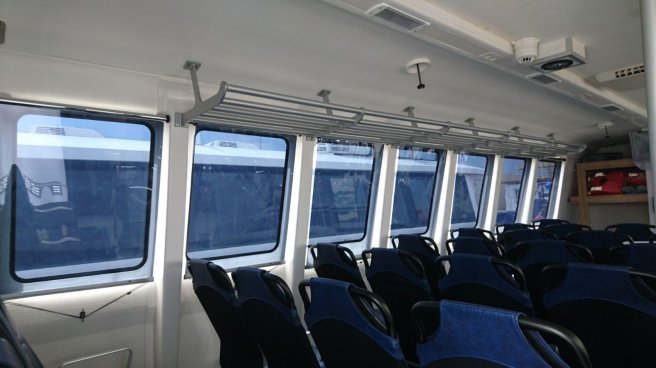Glare from the sun can cause a number of problems onboard ships and yachts like blinding the captain, making navigational screens harder to see, and overheating the interior. Transparent sunshades are a great option for reducing sun glare without compromising visibility. We sat down with sunshade-expert Peter Jones from Sola-Cure Marine Window Blinds to go over the applications & benefits of using sunshades on your boat.
What are solar shades?
Solar shades, also known as sun shades, solar screens, or UV protection shades are boat window blinds that are used to eliminate glare from the sun, reject UV rays and reduce the temperature inside the vessel.
What’s the difference between solar shades and regular roller shades?
Solar shades are designed to combat the sun and block harmful UV rays without compromising the view and roller shades are meant to control or block the amount of light that enters a room and does compromise the view.
Do solar shades provide privacy?
It depends on the time of day. By nature, solar shades can provide privacy during daylight hours because people who pass by cannot see into the room. This effect is reversed when it’s after dark. When the room lights are turned on, solar shades become transparent which allows people to see inside your vessel.
What are the most common applications of solar shades on a ship?
The bridge and wheelhouse are the most important areas as solar shades are an essential safety feature and navigational aid. Other applications include galley windows where daytime privacy is required or where glare on monitors needs to be eliminated.
In other parts of a vessel there may be public areas such as bars, restaurants, gymnasiums, like on board ferries, cruise ships, and large yachts. In these areas, passengers want to see out but remain cool and free from glare.

What are the greatest benefits of solar shades?
The most important benefit is the reduced glare, giving operators a clearer view of where they’re headed as well as making navigational screens clearer and easier to read.
Because solar shades reflect UV rays, they also help to keep the interior of the vessel cool. If the boat is equipped with air conditioning, it will run more efficiently and effectively. We’ve tested Sola-Cure sunshades on a summer day in South Florida and the wheelhouse was 10° F cooler when the shades were in use.
What color solar shades work best?
Since solar shades are primarily for blocking UV rays, there isn’t much variety in color, and are typically available only in neutral colors. Lighter-colored fabrics are better at reflecting heat and brightening the room, but lighter fabrics tend to obscure the view. Darker-colored fabrics are better at absorbing glare which provides a clearer view, but in order to regulate heat, look into a tighter weave (lower openness).
Why would I use solar shades instead of tinted glass?
International Maritime Organization regulations state that shading must be a removable feature. This is why permanent window tints should not be applied, much like rules concerning an automobile. In addition, permanent window tints can make seeing at night or in overcast conditions difficult, so the ability to retract the solar shades as it gets darker outside makes for the best possible visibility in all conditions.
How are solar shades mounted?
Typically they are mounted above or below the window, rolling in and out of a cartridge or cassette. They can also be used on overhead windows and in a few cases they are mounted alongside the window and roll out horizontally. In below-window, overhead and horizontally mounted applications, wire guides are typically required to keep the shade taught and in the correct place.

What material are solar shades made from?
The material is typically some form of polymer film. They can also be made from fabric that has many tiny holes, allowing crew and passengers to see through them but still reducing glare by 99%. While the film offers clearer visibility, fabric can be a bit more durable.
If you’re interested in solar blinds, be sure to check out our next article: Common Questions About Sizing & Installing Sola-Cure Solar Blinds